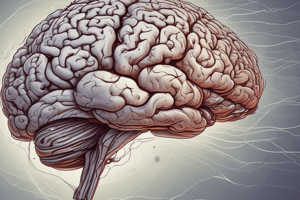Podcast
Questions and Answers
Which neurotransmitter is involved in the feedback mechanism from the postsynaptic neuron to the presynaptic neuron in long-term potentiation (LTP)?
Which neurotransmitter is involved in the feedback mechanism from the postsynaptic neuron to the presynaptic neuron in long-term potentiation (LTP)?
- Dopamine
- Serotonin
- Nitric Oxide (NO) (correct)
- Acetylcholine
Which enzyme is activated by Nitric Oxide (NO) in the presynaptic terminal during LTP?
Which enzyme is activated by Nitric Oxide (NO) in the presynaptic terminal during LTP?
- Phosphodiesterase
- Acetylcholinesterase
- GABA transaminase
- Guanylyl cyclase (correct)
What is the duration of the early phase of LTP?
What is the duration of the early phase of LTP?
- Hours to days
- Days to months
- Months to years
- Minutes to hours (correct)
What is the duration of the late phase of LTP?
What is the duration of the late phase of LTP?
What is the effect of low frequency stimulation (LFS) on EPSP amplitude?
What is the effect of low frequency stimulation (LFS) on EPSP amplitude?
What is the role of the NMDA receptor in both LTP and spatial learning?
What is the role of the NMDA receptor in both LTP and spatial learning?
What is the effect of Alcohol on LTP processes?
What is the effect of Alcohol on LTP processes?
Which drug is controversial in terms of improving memory?
Which drug is controversial in terms of improving memory?
What is the molecular mechanism for memory called?
What is the molecular mechanism for memory called?
Which aspect of memory and LTP formation is involved in CREB?
Which aspect of memory and LTP formation is involved in CREB?
Which stimulation is involved in LTD?
Which stimulation is involved in LTD?
What is the function of physostigmine?
What is the function of physostigmine?
Which drug is known to have cognitive enhancing effects in impaired subjects?
Which drug is known to have cognitive enhancing effects in impaired subjects?
Which learning process involves activity dependent synaptogenesis?
Which learning process involves activity dependent synaptogenesis?
Which protein is involved in memory and LTP formation?
Which protein is involved in memory and LTP formation?
Which drug is known to restore performance in animals with lesions?
Which drug is known to restore performance in animals with lesions?
According to the text, what is the definition of learning?
According to the text, what is the definition of learning?
What is Hebb's rule?
What is Hebb's rule?
What are the three types of memory mentioned in the text?
What are the three types of memory mentioned in the text?
According to the text, what is the connectome?
According to the text, what is the connectome?
What is LTP?
What is LTP?
What is LTD?
What is LTD?
According to the text, what are some drugs that influence memory?
According to the text, what are some drugs that influence memory?
What is the mechanism by which learning occurs and memories can be formed in the brain?
What is the mechanism by which learning occurs and memories can be formed in the brain?
What happens when the hippocampal neuron is individually stimulated by Cell A, Cell B, or Cell C?
What happens when the hippocampal neuron is individually stimulated by Cell A, Cell B, or Cell C?
What happens when cells A and B are activated together in the hippocampal neuron?
What happens when cells A and B are activated together in the hippocampal neuron?
What is the result of repeatedly making the association between the sight and smell of a rose in the hippocampal neuron?
What is the result of repeatedly making the association between the sight and smell of a rose in the hippocampal neuron?
What is the role of long-term potentiation (LTP) in synaptic strengthening?
What is the role of long-term potentiation (LTP) in synaptic strengthening?
What is the specific characteristic of LTP at one synapse?
What is the specific characteristic of LTP at one synapse?
What is the role of CaMKII in synaptic strengthening?
What is the role of CaMKII in synaptic strengthening?
Flashcards are hidden until you start studying
Study Notes
Neuroscience of Learning and Memory: Key Concepts and Drug Effects
- The presentation is for personal use only and must not be copied or used outside of BSMS.
- The brain encodes memories at different levels: electrophysiological, molecular, and structural.
- Drugs like alcohol, benzodiazepines, cholinergic drugs, and cognitive enhancers can influence memory.
- The connectome is the map of neural connections in the brain.
- Learning involves adaptive changes in synaptic connectivity and alters behavior.
- Hebb's rule states that neurons that fire together wire together, strengthening synaptic connections.
- Long-term potentiation (LTP) is a mechanism underlying synaptic strengthening and memory formation.
- LTP involves the activation of protein kinase C and calcium calmodulin-dependent protein kinase II (CaMKII), leading to the insertion of new AMPA receptors.
- LTP can also involve presynaptic events and the release of neurotransmitter nitric oxide (NO).
- Late phase LTP requires new protein synthesis and can involve morphological changes and the establishment of new synapses.
- Long-term depression (LTD) is the opposite of LTP and involves a decrease in synaptic strength.
- NMDA receptor activity in the hippocampus is essential for both LTP and spatial learning, as blocking it with AP5 blocks both processes.
Studying That Suits You
Use AI to generate personalized quizzes and flashcards to suit your learning preferences.



